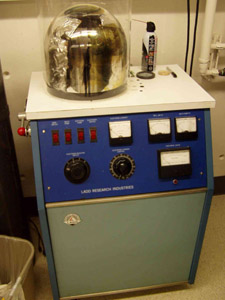Equipment
High Vacuum Evaporator

Model:
Ladd High Vacuum Evaporator
Capabilities:
This tool is capable of thermal deposition of a variety of metals and other materials.
Cost:
Calendar for Reservations:
Specifications:
- up to 4". both basket and boat assemblies.
- carbon deposition from graphite rods.
- rotational sample mount available.
- diffusion pumped with a LN2 baffle for cleanliness.
- simple manual operation of valving and current sources.
(from Wikipedia)
Evaporation is a common method of thin film deposition. The source material is evaporated in a vacuum. The vacuum allows vapor particles to travel directly to the target object (substrate), where they condense back to a solid state. Evaporation is used in microfabrication, and to make macro-scale products such as metallized plastic film. Evaporation involves two basic processes: a hot source material evaporates and condenses on the substrate. It resembles the familiar process by which liquid water appears on the lid of a boiling pot. However, the gaseous environment and heat source are different. Evaporation takes place in a vacuum, i.e. vapors other than the source material are almost entirely removed before the process begins. In high vacuum (with a long mean free path), evaporated particles can travel directly to the deposition target without colliding with the background gas. (By contrast, in the boiling pot example, the water vapor pushes the air out of the pot before it can reach the lid.) At a typical pressure of 10-4 Pa, an 0.4-nm particle has a mean free path of 60 m. Hot objects in the evaporation chamber, such as heating filaments, produce unwanted vapors that limit the quality of the vacuum. Evaporated atoms that collide with foreign particles may react with them; for instance, if aluminum is deposited in the presence of oxygen, it will form aluminum oxide. They also reduce the amount of vapor that reaches the substrate, which makes the thickness difficult to control. Evaporated materials deposit nonuniformly if the substrate has a rough surface (as integrated circuits often do). Because the evaporated material attacks the substrate mostly from a single direction, protruding features block the evaporated material from some areas. This phenomenon is called "shadowing" or "step coverage." When evaporation is performed in poor vacuum or close to atmospheric pressure, the resulting deposition is generally non-uniform and tends not to be a continuous or smooth film. Rather, the deposition will appear fuzzy.
